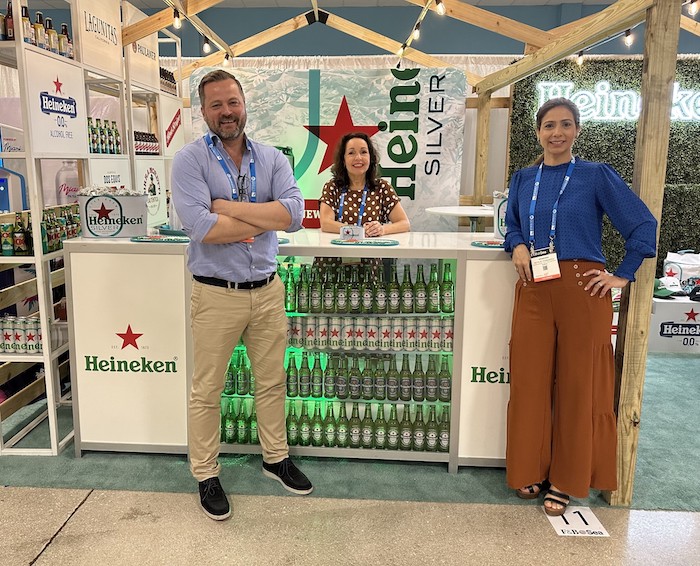Imagine this—you're cruising along the horizon, the salty breeze brushing against your skin, and suddenly your stomach starts growling. Lucky for you, F&B at sea has come a long way from just serving fish and chips. Today, dining on the high seas is an experience like no other, blending luxury, creativity, and flavor in ways that'll leave your taste buds begging for more.
Now, let's be honest. When most people think about "F&B at sea," they picture basic buffets or simple meals served on board. But guess what? That's so yesterday. Modern cruise ships have transformed into floating culinary paradises, offering everything from Michelin-starred chefs to farm-to-table dining experiences. It's not just about eating anymore—it's about indulging.
Whether you're a foodie looking for the next big adventure or someone who simply wants to enjoy a delicious meal while watching the sunset over the ocean, this guide has got you covered. So buckle up, because we're diving deep into the world of food and beverage on the high seas. Trust me, it's gonna be a wild ride!
Read also:Gunnas Rising Influence In South Africa A Star Shining Brighter Than Ever
Here's the deal: The F&B scene at sea isn't just about filling your plate anymore. It's about creating unforgettable memories through food. And that's exactly what we're here to explore together.
What Exactly is F&B at Sea?
First things first—let’s break down what F&B at sea really means. In simple terms, it refers to all food and beverage offerings available on cruise ships, ferries, yachts, and other vessels traveling across the waters. But it's more than just serving food—it's about crafting an experience that caters to every palate and preference.
Back in the day, dining at sea was pretty basic. You'd get your standard cafeteria-style setup with limited options. Fast forward to today, and you'll find gourmet restaurants, themed dining areas, and even live cooking demonstrations. It's a whole new ball game, my friend.
So why does F&B at sea matter so much now? Well, for starters, travelers are becoming more adventurous when it comes to their dining choices. They want unique experiences, fresh ingredients, and dishes that tell a story. Cruise lines have stepped up their game to meet these demands, turning their ships into floating food festivals.
Why F&B at Sea is a Big Deal
Here's the truth—when you're stuck on a ship for days, food becomes one of the highlights of your trip. And let's face it, nobody wants to eat the same thing over and over again. That's where F&B at sea comes in. It offers variety, quality, and convenience all rolled into one package.
For instance, did you know that some cruise ships now feature restaurants by world-renowned chefs? Names like Jamie Oliver, Todd English, and Nobu Matsuhisa are just a few examples of culinary legends bringing their magic to the high seas. These partnerships elevate the dining experience, making it feel like you're eating at a top-tier restaurant back on land.
Read also:J Molley And Emtee A Feud Thatrsquos Finally Over
But it's not just about the big names. Many vessels also focus on local and seasonal ingredients, ensuring that each dish is as fresh as possible. This approach not only enhances the taste but also supports sustainable practices, which is a win-win for everyone involved.
Types of Dining Experiences on Ships
Alright, let's talk about the different types of dining experiences you can expect when it comes to F&B at sea. There's something for everyone, whether you're into fine dining, casual eats, or late-night snacks.
1. Main Dining Rooms
These are the go-to spots for most passengers. Main dining rooms typically offer a wide range of dishes, from classic steaks to vegetarian options. They often follow a set menu format, but some ships allow you to customize your meals based on your preferences.
2. Specialty Restaurants
Looking for something a little more upscale? Specialty restaurants have got you covered. These venues usually come with an additional fee, but trust me, it's worth it. Think lobster bisque, wagyu beef, and truffle-infused dishes. Yum!
3. Buffets
Who doesn't love a good buffet? Buffets on cruise ships are a foodie's paradise, offering everything from international cuisines to dessert stations that'll make your jaw drop. Plus, they're open for multiple meals a day, so you can snack whenever hunger strikes.
4. Casual Dining
Not in the mood for fancy pants dining? No problem. Casual eateries like pizza joints, burger bars, and coffee shops are scattered throughout most ships. These spots are perfect for grabbing a quick bite without breaking the bank.
5. Room Service
Let's not forget about room service. Whether you're feeling lazy or just want to enjoy a peaceful meal in your cabin, most ships offer 24/7 room service. Some even let you order specialty items for an extra charge. Talk about convenience!
How to Maximize Your F&B Experience at Sea
Now that you know what to expect, here are a few tips to help you make the most out of your F&B experience at sea:
- Plan Ahead: Check out the dining options available on your ship before you set sail. This way, you can book reservations for popular restaurants and avoid missing out.
- Try Something New: Don't be afraid to step out of your comfort zone. Order something you've never tried before—you might discover a new favorite dish!
- Ask for Recommendations: The staff on board are usually more than happy to suggest dishes based on your preferences. Take advantage of their expertise!
- Pace Yourself: With so many dining options available, it's easy to overindulge. Remember to pace yourself so you don't end up feeling stuffed all the time.
By following these tips, you'll be able to enjoy a well-rounded F&B experience that caters to your tastes and preferences.
The Role of Technology in F&B at Sea
Technology has played a huge role in enhancing the F&B experience at sea. From mobile apps that let you order food directly to your cabin to digital menus that update in real-time, innovation is everywhere.
For example, some cruise lines now offer RFID-enabled bracelets that allow passengers to make purchases with just a wave of their wrist. This eliminates the need to carry cash or credit cards around, making the dining experience more seamless.
Additionally, many ships have adopted sustainable practices through technology, such as using energy-efficient appliances and reducing food waste through smart inventory management systems. These efforts not only benefit the environment but also ensure that guests receive the freshest ingredients possible.
Challenges Faced by F&B Operators at Sea
Of course, running a successful F&B operation at sea isn't without its challenges. One of the biggest hurdles is dealing with limited space and resources. Unlike restaurants on land, ships have to carefully manage their storage and preparation areas to accommodate large numbers of guests.
Another challenge is catering to diverse dietary needs and preferences. With globalization comes a wider range of food restrictions, allergies, and cultural sensitivities. Ships must be prepared to handle these requests while maintaining high standards of quality and service.
Lastly, there's the issue of waste management. Ships generate a significant amount of food waste, which needs to be disposed of responsibly. Many cruise lines are addressing this by implementing recycling programs and partnering with organizations that turn food waste into compost or animal feed.
Future Trends in F&B at Sea
So, what does the future hold for F&B at sea? Here are a few trends to watch out for:
- Sustainable Dining: Expect to see more emphasis on eco-friendly practices, such as using biodegradable packaging and sourcing ingredients locally.
- Interactive Experiences: Virtual reality cooking classes and live demonstrations will become more common, allowing guests to learn and engage with chefs in new ways.
- Personalized Menus: Advances in AI and data analytics will enable ships to offer personalized menu recommendations based on individual preferences and past choices.
As technology continues to evolve, the possibilities for enhancing F&B at sea are endless. The key is finding ways to balance innovation with tradition, ensuring that every guest has a memorable dining experience.
Real-Life Examples of Outstanding F&B at Sea
To give you a better idea of what's possible, here are a few real-life examples of outstanding F&B at sea:
1. The Ocean Now Restaurant by Nobu
Located on Royal Caribbean's Symphony of the Seas, this restaurant serves up Japanese-Peruvian fusion dishes that'll blow your mind. From black cod miso to yellowtail sashimi, every bite is a celebration of flavor and texture.
2. Jamie's Italian
Celebrity chef Jamie Oliver has partnered with several cruise lines to bring his signature Italian cuisine to the high seas. His menus feature comfort foods like pasta, pizza, and risotto, all made with fresh, wholesome ingredients.
3. The Cheesecake Factory
Yes, you read that right. The Cheesecake Factory has made its way onto several cruise ships, offering a wide array of desserts and savory dishes. It's a heaven for anyone with a sweet tooth!
These examples showcase the incredible variety and quality available in today's F&B at sea offerings. Whether you're craving sushi, pasta, or cheesecake, there's something for everyone.
Expert Insights on F&B at Sea
We reached out to industry experts to get their take on the current state and future of F&B at sea. Here's what they had to say:
"The demand for quality dining experiences on cruises is higher than ever. Guests are no longer satisfied with just eating—they want to be wowed. This has led to a rise in partnerships with celebrity chefs and a focus on creating unique, memorable meals."
"Sustainability is becoming a top priority for cruise lines. We're seeing more emphasis on reducing waste, using renewable energy sources, and supporting local communities through food sourcing."
These insights highlight the importance of staying ahead of trends and continuously improving the F&B experience at sea. By listening to customer feedback and adapting to changing preferences, cruise lines can ensure that their dining offerings remain relevant and appealing.
Conclusion
And there you have it—a comprehensive guide to F&B at sea. From the basics of what it entails to the latest trends shaping the industry, we've covered it all. Whether you're a seasoned cruiser or a first-timer, one thing is certain—dining on the high seas is an experience unlike any other.
So next time you find yourself on a ship, don't just settle for the basics. Explore the variety of dining options available, try something new, and create memories that'll last a lifetime. And remember, the world of F&B at sea is constantly evolving, so keep an eye out for exciting developments in the future.
Before you go, we'd love to hear from you! What's your favorite F&B experience at sea? Or maybe you have a suggestion for something you'd like to see in the future. Drop a comment below and let's start the conversation. Happy dining!
Table of Contents:
- What Exactly is F&B at Sea?
- Why F&B at Sea is a Big Deal
- Types of Dining Experiences on Ships
- How to Maximize Your F&B Experience at Sea
- The Role of Technology in F&B at Sea
- Challenges Faced by F&B Operators at Sea
- Future Trends in F&B at Sea
- Real-Life Examples of Outstanding F&B at Sea
- Expert Insights on F&B at Sea
- Conclusion


